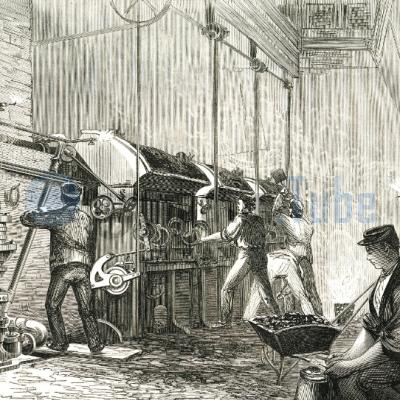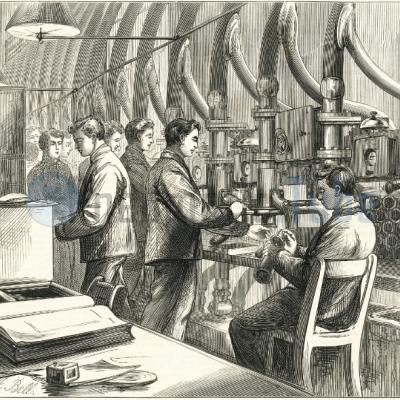Pneumatic Tube, Instrument Gallery
Drawings and text found in The Illustrated London News magazine of 5 December 1874.
THE CENTRAL TELEGRAPH OFFICE
A description of the Central Establishment of Postal Telegraphs at the General Post Office, St. Martin’s-le-Grand, appeared in last week’s Number of this Journal, with some Illustrations of the different classes of instruments there used. The single needle, the old double-needle, Wheatstone’s automatic, the pneumatic puncher, Hughes’s type-printer, the A B C dial, the direct writer, and the sounder were shown in our Engravings, and their respective performances were noticed. Some account was given also of the organization of the Central Telegraph staff, which consists of about 1500 persons, of whom 740 are female instrument clerks, and 500 instrument clerks of the male sex. The arrangement of the instruments attended by them in the instrument gallery, which occupies the whole upper floor of the new building at the corner of Newgate street and St. Martin’s-le-Grand, was explained to our readers and the method of conducting their work. The battery-room, too, on the ground floor, where the galvanic cells or jars are kept, to supply the currents of electric force to a thousand different wires, was also described.
We now present Illustrations of the Pneumatic Despatch Tubes fixed on the south side of the Instrument Gallery, for the conveyance of telegrams, in their first condition as written papers, means of atmospheric propelling power through a underground tube between the Central Telegraph Office and the more important City offices, as well as the offices Ludgate-circus, Temple-bar, and West Strand.
The atmospheric power derived from the air-pumps worked steam-engines. These engines are three, each of 50-horse power nominal; they are of beam construction, and fitted with all the newest appliances for air-pumping, which is principal work. They were made by Messrs. Easton and Anderson, of Erith. Owing to many peculiarities in their construction, they engaged much of the attention of Mr. R. S. Gulley, the engineer-in chief of the postal telegraph department, and his assistants skilled in mechanical appliances. The boilers are four, each horse power, like the engines. They are self-feeding, being fitted with Vieher’s mechanical Stoker - an arrangement which not only saves much manual labor, but admits of the use of cheaper description of coal in the firing. It is shown in our Illustration. coil is conveyed from the cellar, or other receptacle, on a kind of screw, which it into a hopper situated immediately over the mouth of the furnace. By means of what are called “plungers,” it is shot on to the furnace bars beneath ; and as these are made move backwards and forwards this very practical result is produced - that the consumed fuel is precipitated over the back of the furnace, and the fresh fuel is added to the fire one and the same operation. This arrangement is worked by what is mechanically known a “cam.” It possesses the important advantage that it is always under control as regards speed.
The boilers ere supplied with water from an artesian well 400 ft. in depth, of which depth 200 ft. was dug out and brick built, and the remainder was bored in sections of 3 ft., 2 ft., and 18 in. diameter. The water is pumped to the level of the concrete on which the engines are embedded by means of small “grasshopper” engine, and thence to the tanks or cisterns at the top of the building by another engine of similar construction. The engines occupy the whole of the courtyard, or well, of the building at the north end, being contained in engine-house which rises nearly to the level of the first floor of the building. The boilers occupy the opposite court-yard, or “well"; adjoining them, at the south end of the building, is the battery-room.
The air-mains for working the pneumatic tubes are two in number - one for compressed air, and the other for vacuum. are each about 150 ft. long, and measure 18 in, by 9 in. inside. When the pneumatic system was first put in use, the old Central Telegraph Office, in Telegraph-street, there was no great pressure on the tubes ; and, as one message could afford to wait for a second or two while the other was being blown or sucked through, the plan of storing the compressed air in large iron tanks or containers was resorted to. This has now been altered, and the service is made continuous in both directions. These air-mains just described provide the means whereby a continuous service can be maintained, as from their great length and internal capacity they become practically their own containers, or exhausts,” the case may be. They furnish not only the means for working the tubes, but the supply of compressed air for working, we mentioned last week, fifty or sixty pneumatic perforators in connection with the Wheatstone system.
The ends of the several pneumatic tubes descend, in a gradual curve, to within about four feet from the ground the south side of the Central Instrument Gallery. A sort of table or shelf is there fixed. The tubes terminate in a range of brass cylinders, with valves readily opened shut to allow the “carriers” to fall out on the shelf below, or to be put into the tube. An employé, who bears the official title of tube attendant, in constant attendance upon each tube ; and, should he happen for the instant to be disengaged, may be summoned at any moment by an electric bell, to draw out the valve and thus open the tube to receive a “carrier” from the station at the other end of the tube for example, from Leadenhall-street. When this signal received the tube is opened, and out falls the "carrier" - a small case of felt or drugget round smaller cup of frame of gutta-percha - which contains one or two, or perhaps half a dozen or a dozen, message forms, just as they had been handed in over the counter by their respective senders. These are telegrams to be forwarded by the Central Office, which is done immediately, after referring them to the nearest check and sorting table On the other hand, a message may have to be sent, in the same way, from the Central Offices to other offices in London. The tube-attendant puts it into a "carrier," which he inserts at the brass mouth of the proper tube, then turns a handle, and the message starts, to reach its destination in two or three minutes. For the more important offices both "up" and "down" tubes are provided. The offices thus served are West Strand, with Temple-bar intermediate; Coal Exchange, with Cannon-Street intermediate; Fenchurch-street, Leadenhall-street, Stock Exchange, Threadneedle-street, Gresham House; the building which formerly the site of the Central Telegraph Station, now called Moorgate-street-buildins; and the General Post Office - that is to say, the office in the old Post Office building, on the other side of St. Martin's-le-Grand. The offices to which single tubes are worked are Cornhill, the Baltic Coffee-House, Lloyd's, Founder's-court, Mark-lane, Eastcheap, Ludgate-circus (Fleet-street); and, in addition to this, with few exceptions, the whole of the foreign telegraph companies' lines are connected with the Central Telegraph Office by pneumatic tubes. The West Strand and Stock Exchange tubes are 3 in. in diameter, and all the others 2 1/4 in. There are, in all, thirty-two separate pneumatic tubes. The pile of articles which look like cylindrical shot, on the right hand in our Engraving, are the "carriers" in reserve.
We shall continue this subject next week.
Article found in The Illustrated London News magazine of 12 December 1874.
THE CENTRAL TELEGRAPH OFFICE.
In two preceding Numbers of this Journal we have given a series of Illustrations of the different kinds of instruments and apparatus in use at the Central Telegraph Establishment of the General Post Office, St. Martin’s-le-Grand. The Engravings were accompanied by description which had been revised by official person and made correct in all important matters of detail. They comprised not only the electric telegraph instruments of several different classes, but also the pneumatic despatch tubes used for sending written telegram forms between the Central Office and some of the telegraph offices in the City at West Strand. We now give a general view of the Instrument Gallery, which occupies all the upper floor of the new building opposite the General Post Office, and in which the whole of the instruments are placed, and are daily worked more than twelve hundred “instrument clerks,” reckoning altogether those on duty at different hours. The number of female clerks is about 740, but none of these remain on duty after eight o’clock in the evening. It is pleasant scene of orderly and intelligent industry to see them all at work. Some of the special apparatus will be shown in our Illustrations next week.
The author of the articles and the artist of the drawing are unknown. Since it is published far more than 70 years ago, both are believed to be in the Public Domain.
 Pneumatic Tube, Rohrpost, Buizenpost
Pneumatic Tube, Rohrpost, Buizenpost
Pneumatic Tube, Instrument Gallery
Published: 11-12-2018
Last updated: 25-01-2019
Show related articles:
Pneumatic Tube Calendar
30 November 1798 (226 years ago)
Pneumatic transportation was invented by William Murdoch
30 November 1835 (189 years ago)
The pneumatic tube carrier was invented
30 November 1852 (172 years ago)
Josiah Latimer Clark installed a 200m long pneumatic tube system in London
30 November 1853 (171 years ago)
Josiah Latimer Clark issued a patent for conveying letters and parcels by the airpressure and vacuum
7 November 1865 (159 years ago)
The Pneumatic Railway between Holborn-hill and Euston-square formally opened
18 November 1865 (159 years ago)
Commissioning Pneumatic Tube Mail Berlin Germany
11 November 1866 (158 years ago)
Commissioning Pneumatic Tube Mail Paris, France

